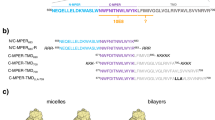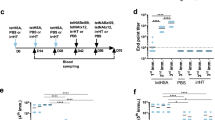Abstract
We describe here a novel type of immunostimiilating complex, called ‘iscom’, in which virus membrane proteins are presented in a multimeric form1–8. The matrix of the iscom is the glycoside Quil A (Spikoside; Iscotec AB), extracted from the bark of Quillaja saponaria Molina9, which forms micelles at the critical micellar concentration of 0.03%. In micelle form, Quil A probably has regions accessible for hydrophobic interaction with the membrane proteins so that it can form complexes with them. Iscoms have been prepared with membrane proteins of para-influenza-3 (PI-3), measles and rabies viruses, and their immunizing potency tested in animals. In these experiments, iscoms prove to be at least 10 times more potent than micelles formed by aggregation of the membrane proteins alone4. Iscoms of PI-3 and measles viruses also stimulate the formation of antibody to the fusion (F) protein, which is considered to be poorly immunogenic10,11. No side effects of iscoms or of protein micelles have been observed.
This is a preview of subscription content, access via your institution
Access options
Subscribe to this journal
Receive 51 print issues and online access
$199.00 per year
only $3.90 per issue
Buy this article
- Purchase on Springer Link
- Instant access to full article PDF
Prices may be subject to local taxes which are calculated during checkout
Similar content being viewed by others
References
Morein, B. et al. Nature 276, 715–718 (1978).
Simons, K., Helenius, A., Morein, B., Balcorova, H. & Sharp, M. in Developments with Human and Veterinary Vaccines (eds Mizrahi, A., Hertman, I., Klingberg, M. A. & Hohn, A.) 217–228 (Liss, New York, 1982).
Morein, B., Sharp, M., Sundquist, B. & Simons, K. J. gen. Virol. 64, 1557–1569 (1983).
Helenius, A. & von Bonsdorff, C. H. Biochim. biophys. Acta 436, 895–899 (1976).
Almeida, J. D., Brand, C. M., Edwards, C. D. & Heath, T. D. Lancet ii, 899–901 (1975).
Helenius, A., Fries, E. & Kartenbeck, H. J. Cell Biol. 75, 866–880.
Oxford, J.S., Hockley, D.J., Heath, T.D. & Patterson, S. J. gen. Virol. 52, 329–343 (1981).
Skelly, J., Howard, C. R. & Zuckerman, A. J. Nature 290, 51–54 (1981).
Dalsgaard, K. Arch. ges. Virusforsch. 44, 243–254 (1974).
Norrby, E., Enders-Ruckle, G. & ter Meulen, V. J. infect. Dis. 132, 262–269 (1975).
Merz, D. C., Scheid, A. & Choppin, P. W. J. exp. Med. 151, 275–288 (1980).
Morein, B., Sundquist, B., Höglund, S., Helenius, A. & Simons, K. Protides biol. Fluids 29, 101–104 (1982).
Martin, R. G. & Ames, B. N. J. biol. Chem. 236, 1372–1379 (1961).
Maizel, J. V. in Methods in Virology (eds Maramorosch, K. & Koprowski, H.) 180–244 (Academic, New York, 1971).
Shibuta, H., Kanda, T., Adachi, A. & Yogo, Y. Microbiol. Immun. 23, 617–628 (1979).
Kirchhausen, T. & Harrison, S. C. Cell 23, 755–761 (1981).
Sundquist, B., Everitt, E., Philipson, L. & Höglund, S. J. Virol. 11, 449–459 (1973).
Sundquist, B., Dalsgaard, K. & Morein, B. Biochem. biophys. Res. Commun. 114, 699–704 (1983).
Luukkonen, A., Gahmberg, C. G. & Renkonen, O. Virology 76, 55–59 (1977).
Seligman, E. B. Laboratory Techniques in Rabies 3rd edn 279–287 (WHO, Geneva 1973).
Dalsgaard, K. Acta vet. Scand. suppl. 69, 1–40 (1978).
Egerton, J. T., Laing, E. A. & Thorley, C. M. Vet. Sci. Commun. 2 247–252 (1978).
Smith, R. D., Aikawa, M. & James, M. A. Science 212, 335–338 (1981).
Arnon, R., Sela, M., Parant, M. & Chedid, L. Proc. natn. Acad. Sci. U.S.A. 77, 6769–6772 (1980).
Wells, P. W., Sharp, J. M., Burrels, L., Rushton, B. & Smith, W. D. J. Hyg., Camb. 77, 255 (1976).
Bakos, K. & Dinter, Z. Nature 185, 549–550 (1960).
Lowry, O. H., Rosenbrough, N. J., Farr, A. L. & Randall, R. J. J. biol. Chem. 193, 265–275 (1951).
McLean, B., Sonza, S. & Holmes, I. H. J. clin. Microbiol. 12, 314–319 (1980).
Towbin, H., Staehelin, T. & Gordon, J. Proc. natn. Acad. Sci. U.S.A. 76, 4350–4354 (1979).
Author information
Authors and Affiliations
Rights and permissions
About this article
Cite this article
Morein, B., Sundquist, B., Höglund, S. et al. Iscom, a novel structure for antigenic presentation of membrane proteins from enveloped viruses. Nature 308, 457–460 (1984). https://doi.org/10.1038/308457a0
Received:
Accepted:
Issue Date:
DOI: https://doi.org/10.1038/308457a0
This article is cited by
-
Enhancing antibody responses by multivalent antigen display on thymus-independent DNA origami scaffolds
Nature Communications (2024)
-
An inventory of adjuvants used for vaccination in horses: the past, the present and the future
Veterinary Research (2023)
-
ISCOM-Matrices Nanoformulation Using the Raw Aqueous Extract of Quillaja lancifolia (Q. brasiliensis)
BioNanoScience (2022)
-
Saponin-based adjuvant-induced dendritic cell cross-presentation is dependent on PERK activation
Cellular and Molecular Life Sciences (2022)
-
The impact of immuno-aging on SARS-CoV-2 vaccine development
GeroScience (2021)
Comments
By submitting a comment you agree to abide by our Terms and Community Guidelines. If you find something abusive or that does not comply with our terms or guidelines please flag it as inappropriate.



